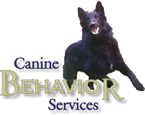 Teaching Your Dog to Stay: 3 Common Mistakes to Avoid Teaching Your Dog to Stay: 3 Common Mistakes to Avoid
Are you tired yet of tips on teaching your dog "stay"? I hope not! Stay is one of the most important obedience commands your dog can master. Not only is it an infinitely useful command for safety and management, it also serves to teach your dog something every good dog should know: self control. And it's certainly one of the most "in demand" behaviors pet owners ask that their dogs learn. So this week, we're still discussing Stay, but this time I'm covering three of the more common training mistakes that can reduce the reliability of your dog's stays. Donning my school marm cap, here are my top three "Please don't do that!" mistakes to avoid when teaching "stay":
#1) Avoid teaching your dog that stay is really a recall. Did your dog start out doing reasonably well on her stays, but now follows after you every time you leave her, or comes to you every time you turn to face her? Let me make an an educated guess: you are in the habit of telling your dog stay, walking away, then turning and calling her to you. There is a good reason why most experienced dog trainers will teach you to always return to your dog to release her from the stay! Calling your dog off the stay is an extremely common training error. What's wrong with it? You are teaching your dog a pattern - that "stay" predicts "come". Your clever, intelligent, eager-to-please dog is simply anticipating what you apparently really want: the recall. ("Recall" is obedience lingo for "coming when called", by the way.) In general, stays and recalls should not be combined, at least not until your dog is very skilled at her stays, and even then, only occasionally. Instead, to release your dog from the stay, go back to her and give a clear release. (I combine a touch on the dog's head at the same time as I give my release word, "okay".) It is recommended that you teach a separate cue (such as "wait") for simply pausing, or for remaining in place until called.
#2) Avoid rewarding your dog for breaking her stay. I imagine you're saying "Duh! I would never do that!". Well, if your dog is continually breaking her stays, it's possible that you are without realizing it. When your dog breaks her stay (more obedience lingo, meaning "moves or gets up from" the stay), do you return her to the spot, have her sit or down again, and then reward her - with treats, praise, petting - once she is back in position? If so, you have effectively rewarded not staying, but the entire sequence of "get up, move away, come back, and sit". In my experience, this is a quick and easy way to teach dogs to break the stay, since most quickly learn that breaking is a surefire way to get a reward. This is not challenging behavior, or dominance, or your dog trying to "put one over on you". It's simply your dog being adept at putting events together. Instead, if your dog breaks her stay, replace her in the position and spot she was in, and remind her to stay, but wait a bit before praising, petting, or treating. How long is "a bit"? It's whatever is reasonable for your dog and the situation. That may be 2 seconds, or 10, or 30, depending on the level of difficulty of the situation and how far you have already progressed in your dog's stay training. Time your reward so that you make it somewhat challenging, while still allowing her to be successful.
#3) Avoid associating the "stay" command with not staying. This sounds like a no-brainer, but people do it all the time. When you tell your dog to "stay" - as so many people do - when you leave him in the house, kennel, car, yard, etc, there is no way your dog can fulfill the definition of "stay": to remain in the same position, and in the same spot, she was in when the cue was given. Your dog learns that "stay" means "you're on your own, dude, see ya later!". So, if your dog is one who, upon being given the stay signal, gets up and casually wanders off, check your routine and see if she might be learning that "stay" means something very different from what you think you have been teaching. Changing your parting phrase to something different (I tell my dogs "Back in a few!"), and only using "stay" for, well, stays, will clear the way for your dog to learn stays without "undue interference".
I hope that helps you polish up those wonderful stays. Next week, on to something completely different! Till then, Happy Training!
julie
Julie Cantrell BSc, CPDT-KA, CDBC
Canine Behavior Services
|

